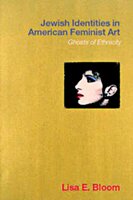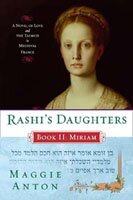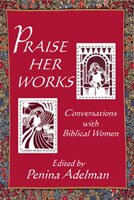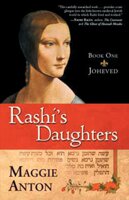|
The Sacrifice of Tamar
By Naomi Ragen
2002, The Toby Press, London, UK, 444 pages
She had, even at the time, removed her mind, her spirit, from the act of the rape. She, the real she, had not been there. But this flesh she carried with her, it had been. She could not forgive it for that. For dragging her down in its humiliation, for not escaping. For compromising her.
While this book is not new, originally having been published in 1995, it was worth a second read and was still an unbelievably written and shocking novel. The book begins with three girls growing up in the sheltered world of Orchard Park, Brooklyn in the early 1970s. Tamar Finegold, a victim of a violent crime, fi nds herself faced with the potential loss of her position as the devout wife of respected rabbi. She keeps the rape a secret from her husband and attempts to live her life forever hiding the ‘scars’. Tamar learns that there is an inherent danger in keeping secrets.
(Reviewed in JTA Issue November 2008)
Rashi’s Daughters – Book II: Miriam
By Maggie Anton
2007 Penguin Group, New York, New York, 475 pages
And if Benjamin’s death wasn’t bad enough, Miriam was now a childless widow required by Jewish law to marry one of his brothers in order to produce a child to carry his name. But Simeon and Ezra were already married, forcing them to perform a special ritual, halitzah, before Miriam would be free to marry someone else… By the time they entered the kitchen, Joheved was nearly shaking in dread of her sister’s reaction.
Once again, Anton, in the second book of this series, immediately pulls the reader into the world of the 11th century. The characters are believable and the story fi lled with emotion, action and insight. Anton’s careful and extensive study and knowledge of the time period and the relevant texts add to the believability of the story. Additionally, the role of the writer in creating historical fi ction lends itself to interesting discussion as does the role of women in Jewish society and in the telling of history. This novel is one that is hard to put down and leaves the reader anxiously awaiting the release of the third and fi nal book in this series, Rachel.
(Reviewed in JTA Issue April 2008)
Sisters At Sinai: New Tales Of Biblical Women
by Jill Hammer
2004, New York, Jewish Publication Society of America, 294 pages
As if in answer to her thoughts, the Voice came winging over the bay: a glass hawk, a mountain’s breath. The world is not ending, only the seventh day. Eve wondered if the segments of an orange all had names. Were they called first, fourth, seventh? Adam and Eve listened with the sharp ears of bats- looking for direction in the soft holy sounds around them.
Sisters At Sinai is a collection of 24 creative short stories based on women in the Torah. The stories are grounded in the Biblical accounts and classic interpretation but yet offer very modern day perspectives. The women come to life in this exciting text filled with well written prose. Her well crafted command of language will keep readers involved in the stories irrespective of their knowledge of Jewish text. Women like Lilith, Eve, Sarah, Hagar, Rachel, Leah and Miriam will now be heard through a different voice and given the respect they deserve.
(Reviewed in JTA Issue August 2007)
Praise Her Works: Conversations With Biblical Women
By Penina Adelman
2005, New York, Jewish Publication Society of America 228 pages
The wife of Noah speaks- You found me. How many thousands of years it has taken, but you found me. I’m not asking why or how. That you did it is a miracle. I’ve learned you can’t force things, just like we couldn’t force God to stop the rain. Survivors need to tell their tales of survival, but there must be willing listeners. Sometimes the silence between the words is all there is.
Penina Adelman, in the course of helping her daughter prepare for her bat mitzvah, came across Midrash Ha-Gadol (The Great Commentary), which refers to 22 righteous biblical women. She devotes one chapter to each woman and reflects upon how they would have felt. She also includes a chapter to allow for Vashti to speak as well. She gives voices to women, some of whom do not even have names. She includes the relevant text and appeals modern readers. It is a highly intelligent and very creative work with a modern feminist, orthodox perspective.
(Reviewed in JTA Issue August 2007)
Voices of the Matriarchs
By Chava Weissler
1998, Boston, Massachusetts, Beacon Press, 269 pages
It was she who showed the women how to pray: what hymns to say, when to rise, when to stand on tip-toe in the kedush prayer. In the women’s gallery of the synagogue…She would read with great emotion, her melody melting the soul and pulling at the heart strings. When she wept, everyone wept with her; her tears would have melted a stone.
In this book, a finalist for the National Jewish Book Award, the spiritual realm of women is reclaimed. Weissler gives a careful and in-depth examination of the Yiddish prayers (thkines) developed by women while excluded from the public domain for centuries. She gives a voice to women, silenced by history, and makes the rich world of spirituality that they created for themselves come alive.
(Reviewed in JTA Issue February 2007)
 |
Jewish Identities in American Feminist Art hosts of ethnicity
By Lisa Boom
2006, New York, New York, Routledge, 188 pages
My art saved me. My parents didn’t speak Hebrew. Instead, they spoke French and Arabic. The language was always a barrier both for them and myself. I found it easier to draw since I couldn’t communicate through the official languages.
Lisa Bloom carefully deconstructs feminist art in the United States and explores the role that Jewishness plays in the creative process for a number of well know artists. The book showcases nearly seventy pieces of art and uncovers the ghosts of ethnicity within them. Bloom takes the reader on a journey to understanding the complex relationship and influence of feminism, nationality, ethnicity, religion, assimilation and personal history on the artists’ work. She further explores how Jewishness, through assimilation, became a ‘ghost of ethnicity’ that although somewhat hidden, remained a driving force for these artists.
(Reviewed in JTA Issue February 2007)
Rashi’s Daughters (Book One) - Joheved
By Maggie Anton
2005, Glendale, California, Banot Press, 369 pages
I can’t teach Joheved from the Talmud: women aren’t allowed to study Talmud. Yes, you can. You know it isn’t actually forbidden…Joheved might understand; she knows the Bible, both in Hebrew and Aramaic. Your mother saw to that. If only I had a son to teach.
Following eight years studying books and articles in English, Hebrew and French; consulting Jewish, genealogy and medieval scholars; re-reading Talmudic texts and visiting Troyes, France, Maggie Anton recreates the story of Joheved, the eldest daughter of Rashi. Anton has conscientiously made certain the portrait she has created is as true to life as possible given the silence regarding the true lives of women in the eleventh century. The century itself and Rashi’s world come alive as does the actors in it. She re-imagines history and creates a vivid portrait of women we know little of. The book leaves the reader anxiously awaiting the release of Book Two- Miriam.
(Reviewed in JTA Issue November 2006)
Reading Women of the Bible
A New Interpretation of Their Stories
By Tikva Frymer-Kensky
2002, New York, New York, Schocken Books, 446 pages
The women of ancient Israel have carved a place for themselves in our consciousness. Sarah, Rebekkah, Rachel and Leah are the mothers of Israel; the biblical Eve is our mother…Children walk around today bearing the names of Miriam and Deborah, ancient leaders, poets, and prophets, and the names of Abigail, Yael, Ruth, Naomi, and Esther, heroines and queens of the Hebrew Bible.
In this comprehensive text, Tikva Frymer-Kensky examines images of the women of the Bible. She discusses the historical reality that each of these women experienced. The women are labeled and divided into distinctive categories: “woman as victor,” “woman as victim,” “woman as virgin (bride to be),” and “woman as voice (of God).” She deconstructs the stories and traditional interpretations in order to reexamine them. Frymer-Kensky displays a tremendous capacity to carefully read the texts and use them as a forum for exploration of modern dilemmas.
(Reviewed in JTA Issue October 2006)
What do you like to read?
Please submit your book reviews to
Jewish Times Asia. Please include an excerpt from the book.
Please email:
This e-mail address is being protected from spambots. You need JavaScript enabled to view it
|



























